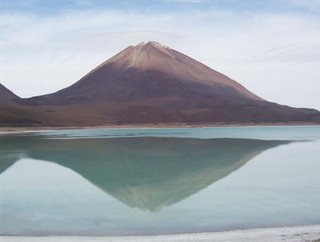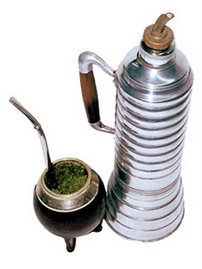 Camisaki Amigos!
Camisaki Amigos!Bolivia has been, without a doubt, the most challenging country I have visited in South America. This email however, is about the lighter side of things (the darker side will follow, just you wait…) I travelled with Phil from Manchester for the first two weeks and he and I got on like a house on fire. He has sent me some piccies that I will refer to in this email. Here goes…
Tupiza will be remembered for doing next to nothing for four days: half-heartedly attempting to "summit" the surrounding red cerros (hills) , trying Bolivian ice-cream (a not-to-be-repeated experience) and listening to extracts of Withnail and I on Phil´s mini-disc (Stop it Withnail, you´re giving me the fear!) On the way from Tupiza to Uyuni we also had our first coco-leaf-chewing experience, although all I remember is a numb cheek because of the catalyst, and the awkwardness of when and where to spit out the cud!

The only way to see the Salar de Uyuni (the world´s biggest salt flats) , other than cycling across it, is to do an organised 4x4 tour. Despite my abhorrence of this sort of tourism, I really enjoyed the tour. Highlights were the Isla de Pescadores, crossing the desolate Dali-esque landscape (Arbol de Piedra and Valle de las Piedras), stopping to view lagunas and volcanoes and swimming in aguas calientes at 7am on a chilly morning. Then there was the soccer game with the local kids of one of the villages where we stayed. Our reps from the UK, Sweden, Norway and SA must have looked like a group of geriatrics puffing and panting, trying to cope with the altitude! Good Friday saw a rather bizarre but seemingly standard procession of purple-cladded KKK-like figures carrying a crowned Jesus in a glass coffin, surrounded by white-helmeted army men and followed by the candle-bearing rest-of-the-town.

Easter Sunday was spent wallowing in the aguas thermales of Laguna Tarapaya outside Potosi and gorging on Easter eggs. Easter Monday, in contrast, was one of the most uncomfortable yet educational days of my life. We went on a tour to Cerro Rico, the world´s highest working mine and one where everything, and I mean everything, is still done by hand. Our group of 5 were made to walk or crawl through tunnels and breathe in dust for two whole hours. This, however, is nothing compared to what the miners have to endure. They work for 8 hours minimum for a pittance, fully aware that they are likely to die at an average age of 45 from TB. 60% of the town works in these mines, some in the hope of striking it rich, but most as an alternative to poverty. To numb the effects of reality in the mine, they live on coco-leaves, pure tobacco and 96% alcohol, of which we were made to try some. Needless to say, I gave most of mine to the Pacha Mamma, as is custom among the miners.

Twenty tourists have disappeared in LaPaz since the start of this year. It therefore did not help that our bus arrived an hour and a half early (at 05:00 in the morning), although I quickly forgot about the fear upon noticing the fairy-lights stretching into every direction on the surrounding black hills. In daylight, these fairy-lights would become brown brick houses, but no less intriguing for leaking into every livable corner of the area. LaPaz is surrounded by the spectacular snow-capped Illimani (6402m), green valleys on the Peru-side and moonlike landscape on the opposite side. We didn't do too much in LaPaz (one doesn't tend to, at 3660m above sea level), but wandered around the city, watched the thriller Hostal (not recommended for the faint-hearted) and were ever-intrigued by the magic charms, llama foetuses and the dead frogs of the Witches´ Market: varnished, glittered and glass-eyed.

Phil and I went our separate ways after 2 weeks, him leaving for Copacabana and me for Sorata. Sorata is sold as Bolivia´s ´Trekking Capitol´, but I merely spent three days wandering around the village, witnessing inebriated locals dancing in the streets as part of a festival, and doing some introspection. And picking up bedbugs – grrr!

Except for a nasty case of food poisoning, I spent a most idyllic four days on the Isla del Sol on Lake Titicaca with Adrian, a crazy Swiss alpinist, and Robin, a super-groovy chick from Portland, Oregan. We walked from Copacabana to the closest point to the island, then crossed the island from South to North (me slowing the whole thing down with my post-food poisoning weakess!) We stayed at hostels but cooked meals on the very slow stove given to me by a German in Patagonia, and also attempted the very refreshing waters of the lake – brrr!
Next: Tomorrow I cross the border to Peru at Puno and within the next few days I will head to Cuzco for a culture overload – yay
I love Bolivia, but what does Bolivia think of me?
It is 7am in Sorata, Bolivia´s ´Trekking Capitol`. Above the town, a little to the right, loom snowcapped Illampu and Ancohuma, both over 6300m. I am walking towards them rather arbitrarily, not having planned to go this far before breakfast. On my way, I pass several Bolivians: an old man with a colourful package on his back, a young girl with a large hat, a mother and her child. I greet them with enthusiasm but I sense that they would rather not have seen me.

After two weeks of experiencing Bolivia with a friend, I have been looking forward to traveling alone again. Traveling alone is good: your eyes are more open to the world, you are more aware of your surroundings, and at the same time, you are more approachable to people who are less likely to initiate contact with a couple or group. Now, however, with every new local I meet, my expectations are challenged. Every smile is met with a stern expression; every ´Bom dia´ with a muffled response. What do they see, when they see me? A European? An American? Certainly not a South African. And would it make a difference, knowing that I also come from the third world? No, it would not. What do I, as a middle class white South African know of poverty anyway, never having experienced it?
It may be presumptuous of me to automatically link the indifference of the locals towards me with poverty. But what, with my Calvinistic background, a guilt complex about the haves and have-nots is never far away, and can perhaps be linked to the attitudes of the people of a country. Out of all the countries in South America, Bolivia is the poorest. Under the bright colours, the bowler hats and the frilled costumes lie decades of hard living. To give an example of the political turmoil, before 2003, Bolivia had experienced 192 changes of government in 178 years. Over the past century and a half, it has suffered several vitally economical territorial losses to its neighbours, including its coastline to Chile. And I won`t even get started on the effect of US `War On Drugs` on Bolivian economy.
Poor countries, as is always the case, are cheap ones too. It comes as no surprise, therefore, that Bolivia is a haven for tourists. I have always despised the term ´tourist´, wanting to confine it to stickered and capped packaged tour-groups. And yet, I am no different. I come to Bolivia to take home with me images of the spectacular and varied scenery. I buy brightly-coloured souvenirs. I eat cheap food and drink cheap beer. I take, I take, and, because everything is so cheap, I take for granted what this country gives me as a foreigner.
But I also forget. I forget the shoeshine boys of LaPaz, who wear balaclavas and caps to hide their identity, as they are supporting their families and financing their education. I forget the mineworkers of Potosi, who work in inhumane conditions at a high altitude, fully aware that they may die at age 45 from TB. I forget about the old ladies with stumped fingers, digging in the dirt for potatoes. I forget about the children, all the children, who work in shops, hostels, kitchens, anything to support themselves and their families. I forget because I want to, and because I can.
Perhaps there is some truth in the idea that the tourist and the local can never be part of each other´s realities. I might come from the world´s poorest continent, but that doesn't mean I can relate to poverty. On the contrary, I have to freedom to travel for five months without working. I have the luxury of travel as my continuing education. In contrast, 77% of Bolivian women are illiterate and each woman will give birth to an average of 3.3 children. I will never be part of this reality, merely a brief witness to it. How then, can I ever identify with the locals, and they with me, coming from a different world with a different world-view?
On the bus from Sorata to LaPaz, I ask a man in front of me about the road. By November, he says, this single dirt track will be a tarred double-carriageway. I feel better for initiating the first proper conversation in three days, and realize that part of the problem is overcoming my own shyness in a more challenging environment. Either way, I will probably never know from experience what it is to be observed from the outside, or objectified as a cultural phenomenon through the lense of a camera. My new resolution, when feeling alienated, is to get over myself and ask locals how they feel about tourists. Because an honest reply from a local is better than spending one´s time caught up in assumptions and speculations, and never really knowing.
The man in front of me on the bus calls to the bus-driver to stop, ´Por la tourista!` I get off and wait for another bus to Copacabana feeling lighter than before, and ready to enjoy my last week in Bolivia. Travel, after all, will always be a combination of enjoyment and personal growth, and it is this combination on which I thrive.










No hay comentarios.:
Publicar un comentario